| Columns Retired Columns & Blogs |
The Sumptuous and Sonorous Bowers & Wilkins P7
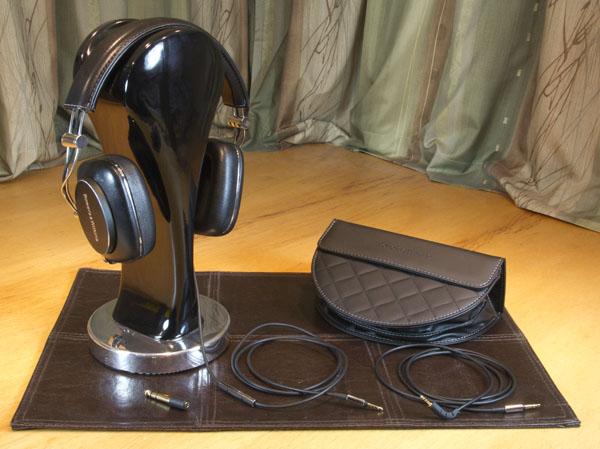
This story originally appeared at InnerFidelity.com
Bowers & Wilkins P7 ($399)
I think we're entering a wonderful time: Full-size, sealed headphones are getting better and better! In roughly the past year we've seen the Sennheiser Momentum, NAD VISO HP50, Focal Spirit Classic, and V-Moda M100 (for the bassheads) appear, all of which represent significantly better sound quality than models previously available. In years past, the Denon ADH-D5000 was my benchmark for over-ear, sealed (even though they don't isolate well) headphones. When I now compare them to the above cans, they sound loose in the lows and splashy up top. Yes sir, there's some good over-ear sealed cans coming out these days...and with this review, I'm adding the B&W P7 to the list.
Style and Substance
Drop-dead sexy? Yeah, that about covers it, the B&W P7 is a spectacularly beautiful headphone. Beautifully tanned, soft black leather wraps the headband, ear cushions, and outside of the ear-capsules. Headband sliders, hinge, and the swooping capsule arms are all polished and gleaming stainless steel. Outer capsule cover is brushed and black anodized aluminum with raised and brushed Bowers & Wilkins logo. In writing this paragraph I've twice removed them from my head just to get another little sniff of their warm leathery goodness. These cans radiate a glow of sumptuous quality...I'm certainly smitten.
Ergonomics, Comfort, and Accessories
Overall, I'd characterize the comfort of these headphones as good, but not great. I find the ear-pads a little stiff and the pressure around my ear is a bit more pronounced than I'd like. Most good headphones are using memory foam in their cans these days, which seems to do a very good job of distributing ear-pad pressure a little more broadly. Take a look at the Sony MDR-1R ear-pad (one of the most comfortable I've experienced) and you'll notice the protein leather is very thin and supple, and the memory foam very soft. The NAD HP50 is similar, but a tad stiffer. The P7 does not use memory foam, which means the ear-pads are always trying to return to their original shape, and I find the pressure from the pad around my ears slightly bothersome. So, not uncomfortable, just not the last word in comfort.

Red circle identifies the corner of the ear-pad plate, blue line shows position of ridge around inside of ear-pad, behind leather, that can touch your ear.
Also, the magnetically removable plate to which the pads are attached is about 1/4" thick; this plate creates a shallow well inside the bottom of the ear-cup. I find the tips of my ears sometimes touch the corner of the plate behind the leather inside the ear-cup making for a little sore spot after long listening sessions. On the other hand, the MDR-1R has a little plastic ridge that can similarly be a minor irritant; and the Sennheiser Momentum has other, more significant, fit problems. To try to put this in perspective, while I've commented on these issues I don't think they're much of a problem, most people will find these fairly comfortable headphone.
The other ergonomic issue worthy of note is the size when packed, and ease of transport. The hinged folding mechanism of the B&W P7 does significantly reduce it's overall size, but because the pads don't rotate flat it remains almost 3" thick. Unlike its little brother the B&W P5 that folds flat, the P7 is a little too thick to stow in briefcases and bags conveniently...though it will usually fit. The included artificial leather, firm-sided carry case is half-moon shaped and measures 8" along the flat edge, 5" perpendicular to the edge, and 3" thick; the headphones fit quite snuggly in the case and the cable does not need to be removed for storage. It's a bit of a lump, but far smaller than the Momentum case, and it feels a bit cheap relative to the headphones. None-the-less, it's perfectly adequate to the task.
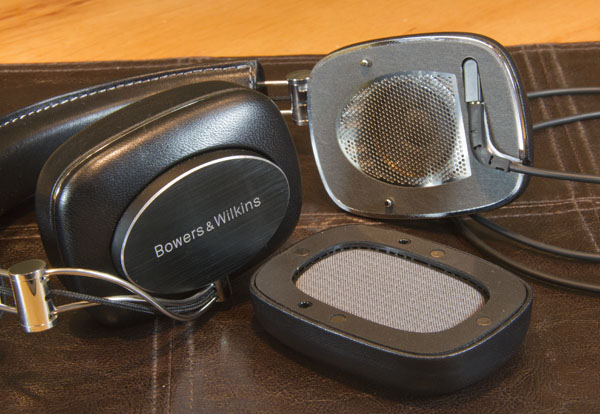
The ear-pads are held on to the ear-capsules with small magnets—a firm tug and they pop off for changing the cable, or when pad replacement is needed. Replacement pads are available. Under the left ear-pad is a small channel into which the cable is guided to a 2.5mm stereo jack that is mounted on a pivot so as to allow easy access and egress for the plug. The cable has a special strain relief molded to the shape of the channel. Replacing the cable with an aftermarket cable will be difficult, if not impossible. The P7 comes with two 48" long cables; one plain and one with Apple compatible remote. The other end of the cable is terminated in a straight and slender 3.5mm plug with metal housing. I prefer 90 degree, or better yet 45 degree, angled plugs to reduce strain on your player's jack.
Technological Innovation
My skeptomometer usually starts blinking pretty hard when I see companies claim new technological innovations improving the sound of their headphones. Sometimes a company puts well-meaning effort into a technology but the result just doesn't seem worthwhile, and sometimes companies are just full of baloney, but either way shouts of innovation often don't seem to pan out in my experience. This, I'm very pleased to say, doesn't seem to be the case with the B&W P7—these headphones seem to be sporting some cool technology that does seem to pay out in sound quality. I spent a little time on the phone with Stuart Nevill, B&W's Head of Engineering, to discuss the technical details of the P7. Check out the P7 technologies blog page here as you read further.
Dual Cavity Ear-Pad
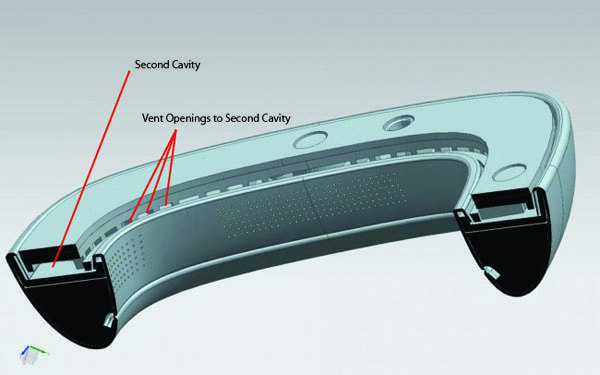
Mechanical illustration showing the P7 ear-pad backing-plate assembly details including second cavity and vent holes to cavity.
Ear-pads have a huge effect on sound quality. Many makers carefully select the ear-pad cushion material and the acoustically permeable fabric around the inside of the ear-cup to carefully tune the ear-pad response. It seems B&W have chosen an alternate method by building into the ear-pad base-plate an acoustically tuned chamber. On B&W's P7 technical info page, they claim this chamber "...maintains a consistent volume of air between the drive unit and the surface of the ear at both sides of the head." I can see how this chamber will maintain it's volume, and therefor tuning, and produce some control on the acoustics of the headphone that won't vary, but I don't see how it would compensate for the differing sizes (volume) of people's ears in the headphones to maintain a "consistent volume of air." I appreciate the fact that they've put some information up (most companies don't do it at all) but wish it would be a little more complete.
In my dialog with Stuart, he said this acoustic filter acted primarily in the 3kHz and 7kHz regions. Headphones will often have a dip in the (compensated) frequency response in this area. It seems to me this is a novel and very smart way to add some acoustic control and deliver a consistant aspect of performance of the ear-pad.
Driver with Surround
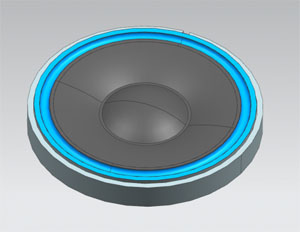 Bowers & Wilkins is, of course, a very, very experienced speaker driver maker. Focussing this expertise on headphone drivers this time, B&W has developed in the P7 what amounts to a miniature cone speaker driver with surround. (Surround in blue in illustration at right.) Most headphones use a diaphragm with its outer edge fixed requiring the diaphragm to flex near the edges to accomodate the forward and back movement of the driver. This flexing at the edge of a normal headphone diaphragm at a minimum disrupts the perfect pistoning action of the diaphragm surface, but also causes other problems because the diaphragm has to be thin and flexible enough to accomodate the movement and therefor is also more likely to suffer modal vibrations, and because the fixed edge adds another mechanical input for modal vibrations.
Bowers & Wilkins is, of course, a very, very experienced speaker driver maker. Focussing this expertise on headphone drivers this time, B&W has developed in the P7 what amounts to a miniature cone speaker driver with surround. (Surround in blue in illustration at right.) Most headphones use a diaphragm with its outer edge fixed requiring the diaphragm to flex near the edges to accomodate the forward and back movement of the driver. This flexing at the edge of a normal headphone diaphragm at a minimum disrupts the perfect pistoning action of the diaphragm surface, but also causes other problems because the diaphragm has to be thin and flexible enough to accomodate the movement and therefor is also more likely to suffer modal vibrations, and because the fixed edge adds another mechanical input for modal vibrations.
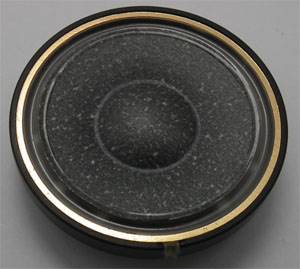 B&W have chosen to go with something they know a great deal about, and designed the 40mm Driver of the P7 to have a stiff pressed-polymer fiber cone with a surround. (The B&W P7 driver can be seen in the photo at right.) This is unusual, but not unique—the drivers in the Denon AH-DX000 headphones have a similar pressed polymer microfiber diaphragm with surround. Theoretically, a surround allows the driver diaphragm to be much stiffer and its surface act more piston-like over the audible range (less modal break-up). There are lots of compromises though, for example the stiffer diaphragm might also be heavier and harder for the voice coil to accelerate. Fortunately the truth comes out in the listening (and measurements) with all this technical innovation stuff...and both the listening (and measurements) with the P7 were quite good.
B&W have chosen to go with something they know a great deal about, and designed the 40mm Driver of the P7 to have a stiff pressed-polymer fiber cone with a surround. (The B&W P7 driver can be seen in the photo at right.) This is unusual, but not unique—the drivers in the Denon AH-DX000 headphones have a similar pressed polymer microfiber diaphragm with surround. Theoretically, a surround allows the driver diaphragm to be much stiffer and its surface act more piston-like over the audible range (less modal break-up). There are lots of compromises though, for example the stiffer diaphragm might also be heavier and harder for the voice coil to accelerate. Fortunately the truth comes out in the listening (and measurements) with all this technical innovation stuff...and both the listening (and measurements) with the P7 were quite good.
Acoustic Damping in Capsule
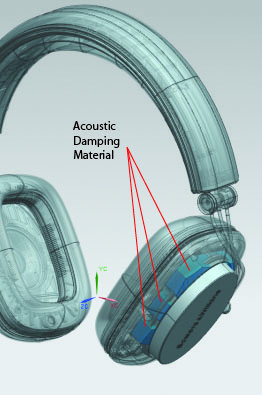 Finally! It's about time someone started putting damping materials in the capsule behind the driver. Speaker manufacturers like B&W have been putting acoustic wadding in speakers since forever. DIY headphone geeks do it all the time and just shake their heads as they see headphone after headphone produced without any damping of this type. Okay, the Sennheiser Amperior has a bit of foam damping in it, but as a rule headphone makers seem averse to the practice. In my chat with Stuart I asked if the material was an acoustic foam or wool material. He said they tried many materials, but ended up using the same acoustic wool batting they use in their speakers. He also commented that I shouldn't be too hard on manufacturers as this type of material can migrate and get tangled up in the cables and mechanically moving bits inside the headphones, but as a speaker manufacturer he said it seemed silly not to try to optimally damp the headphone's rear chamber in this way.
Finally! It's about time someone started putting damping materials in the capsule behind the driver. Speaker manufacturers like B&W have been putting acoustic wadding in speakers since forever. DIY headphone geeks do it all the time and just shake their heads as they see headphone after headphone produced without any damping of this type. Okay, the Sennheiser Amperior has a bit of foam damping in it, but as a rule headphone makers seem averse to the practice. In my chat with Stuart I asked if the material was an acoustic foam or wool material. He said they tried many materials, but ended up using the same acoustic wool batting they use in their speakers. He also commented that I shouldn't be too hard on manufacturers as this type of material can migrate and get tangled up in the cables and mechanically moving bits inside the headphones, but as a speaker manufacturer he said it seemed silly not to try to optimally damp the headphone's rear chamber in this way.
Other Technologies
A few other technologies are pointed to on the blog page including: a resistive speaker basket; a braced speaker baffle; and a light-weight aluminum voice coil. I'm sure they've done a good job of designing them or they wouldn't have mentioned it, but these features are fairly common in dynamic headphones.
Flip the page for the good stuff: sound quality and isolation...
- Log in or register to post comments




































